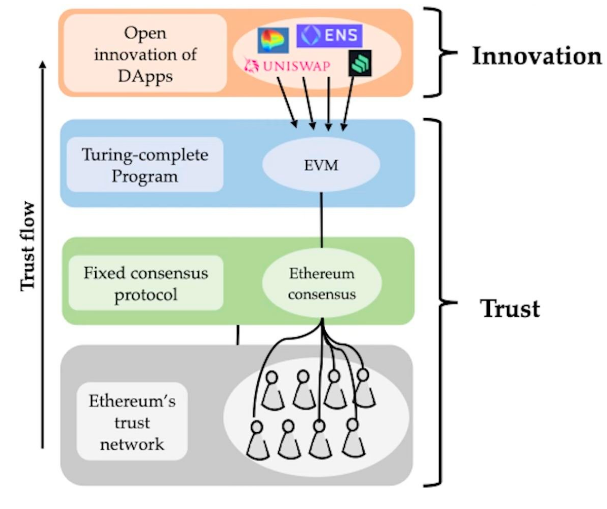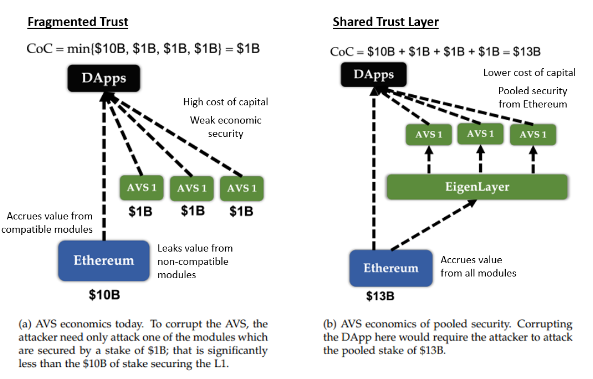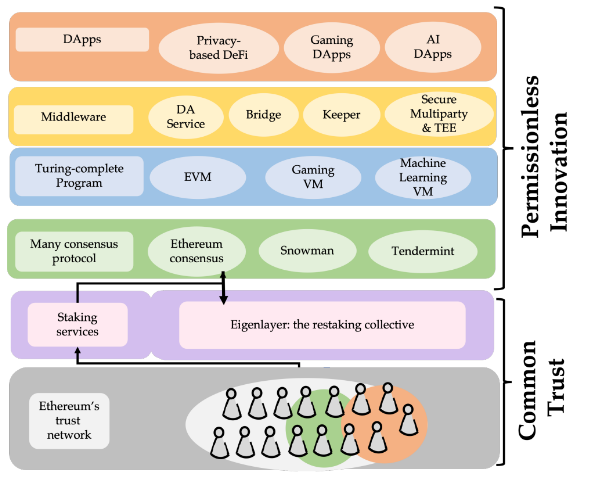Bixin Ventures: EigenLayer will become the guarantee of ETH trust layer
Original Author: DX, Henry Ang, Mustafa Yilham, Allen Zhao, Jermaine Wong & Jinhao, Bixin Ventures
The blockchain is called a "trust machine". Users build a network without permission from a centralized regulator (permisionless) - Bitcoin is the starting point for everything. It helps miners reach a consensus on value distribution through the PoW consensus mechanism to create a trust layer, all value transmission occurs on this trust layer.
But one problem with Bitcoin is that it is more like a single application chain (application specific blockchain) that only supports transfer functions. Other applications such as Namecoin need to create their own trust layer in order to run, which sets a huge barrier for application innovation. obstacle. Ethereum's groundbreaking is that it adds a general-purpose Turing-complete execution layer (ie, EVM) on top of Bitcoin's innovation. After splitting the application layer and the trust layer, the application can directly deploy its own smart contract on Ethereum, and get the security guarantee of the trust layer, without having to create its own trust layer from scratch.

After The Merge, Ethereum changed from the PoW consensus to the PoS consensus. Compared with the PoW mechanism, which requires miners to use hardware to compete for computing power to reach a consensus, the PoS mechanism requires nodes to pledge a certain amount of funds to vote to reach a consensus. Honest nodes are rewarded by the network. , will also be penalized for this, which has two advantages:
First of all, the penalty mechanism can increase the cost of corruption (Cost of Corruption) without changing the profit from corruption (Profit from Corruption), which helps to improve the economic security of the trust layer.
Secondly, the protocol implements a finer governance structure for nodes, and guides node behavior in more dimensions while expanding node governance capabilities. For example, Ethereum can dynamically determine the confiscated amount of malicious nodes according to the total confiscated amount within a period of time, and increase the punishment for malicious colluding nodes; or ininactivity leakMode, that is, when too many nodes go offline so that the consensus cannot reach finality in four epochs, Ethereum can recover the finality by confiscating the funds of the offline nodes to ensure the activity of the entire network.
first level title
Limitations of the Ethereum Trust Layer
The management of the trust layer in Ethereum is based on the slashing mechanism at the consensus protocol level. When non-Ethereum applications want to use the trust layer of Ethereum, there is no way to deal with the funds of nodes that violate the application rules but abide by the consensus rules of Ethereum. Forfeit. In other words, these non-Ethereum applications cannot directly use Ethereum's trust layer as a foundation.
first level title
re-pledge
re-pledge
Facing the limitations of the Ethereum trust layer, EigenLayer uses restaking (restaking) to expand the penalty mechanism of the Ethereum trust layer. EigenLayer creates a new smart contract-level slashing mechanism through the smart contract in charge of the node's fund retrieval certificate.
secondary title

Trusted Trading Market
first level title

Externalities of EigenLayer
secondary title
positive externality
1) Accelerate application layer innovation
By establishing a trusted trading market, Eigenlayer further splits and modularizes the trust layer and execution layer of Ethereum. Non-Ethereum applications can use the modular trust layer to easily gain trust, greatly reducing the capital threshold for building security. This brings huge benefits to applications and middleware protocols that value economic security such as oracles, data availability layers, decentralized sequencers, cross-chain bridges, sidechains, etc., allowing them to focus on protocol innovation and user experience. Similar to the Web3 social protocol, when social data sinks to the data layer, and all social protocols can easily access the data layer without permission, application innovation and user experience will be rapidly improved.
2) Help the protocol layer innovate
Since EigenLayer has a slashing mechanism with the same effect as the consensus protocol at the level of the smart contract, it can also create some other rules for nodes to choose to abide by without changing the existing consensus mechanism, so as to achieve the effect of a kind of consensus mechanism.
For example, to solve the single-slot finality problem, Ethereum currently uses the Gasper protocol, which can only provide finality for the first block (checkpoint block) in each epoch, and cannot provide finality for each slot in the epoch for the time being. But by using EigenLayer, the node guarantees to choose to continue to build along the main chain containing a block of a certain slot so that each slot has finality, and the node that violates the promise will be fined and confiscated.
Another example is to address thepartial-block MEV-Boostquestion. Currently, block builders (builders) can only submit complete blocks through MEV-Boost, and block proposers (proposers) can only see complete blocks after signing the block header and guaranteeing to add blocks according to the builder's idea Content - This is to prevent proposers from plagiarizing blocks for their own profit.
EigenLayer allows the builder to submit some blocks, and the remaining blocks are constructed by the proposer himself. When the proposer fails to include part of the builder's transactions into the final block as agreed, its funds will be fined by EigenLayer. In this way, a wider range of block proposers can also participate in block construction and obtain part of the MEV revenue, thereby inhibiting the centralization of block builders. In addition, since more centralized block builders cannot be responsible for the construction of all blocks, proposers randomly selected by the consensus mechanism can also participate in block construction, improving the anti-censorship of Ethereum transactions.
3) Facilitate the economic security of the Ethereum trust layer
EigenLayer allows Ethereum nodes to choose to obtain additional benefits after measuring the risk-benefit ratio, and the rate of return of Ethereum node pledges will become higher, which will further lead to more ETH being used for pledges and promote the economic security of Ethereum As well as the security provided for the application protocol, forming a good positive feedback.
4) Improve the decentralization of the Ethereum trust layer
secondary title
negative externalities
1) The damage of abnormal slashing to the trust layer of Ethereum
In addition to the normal slashing caused by violating the rules, the entire system may also have abnormal slashing due to code bugs or malicious agreements. Even honest nodes will be fined for pledged funds. When abnormal slashing leads to large-scale slashing of honest nodes, the economic security of the Ethereum trust layer will also be greatly damaged.
To reduce this negative externality, EigenLayer takes two approaches. The first is to reduce risks through strict auditing, and the second is to provide a one-vote veto system for fines and confiscations. The governance committee can veto one-vote fines and confiscations through multiple signatures, providing a guarantee for extreme situations.
2) Trust leverage created by re-pledging
Summarize
Summarize
In the future, the blockchain will enhance its performance through a high degree of modularization and outsourcing of some responsibilities. EigenLayer is building something that will not only benefit the entire Ethereum ecosystem, but the ecosystem beyond Ethereum. In addition to the points mentioned above, EigenLayer's positioning is to completely change the current block limit model, and become a new test field to break the trade-off between Ethereum democracy and flexibility by utilizing the node excess resource pool, so as to provide new business Patterns inject more possibilities.
At the same time, EigenLayer is also working on new products including EigenDA, Ethereum's hyperscale data availability layer, which aims to achieve cheaper, more consistent fees, and higher data availability bandwidth. EigenLayer also plans to cooperate with teams such as Mantle Network to push this technology to broader scenarios. We are very much looking forward to seeing how EigenLayer will affect the future development of L2.



